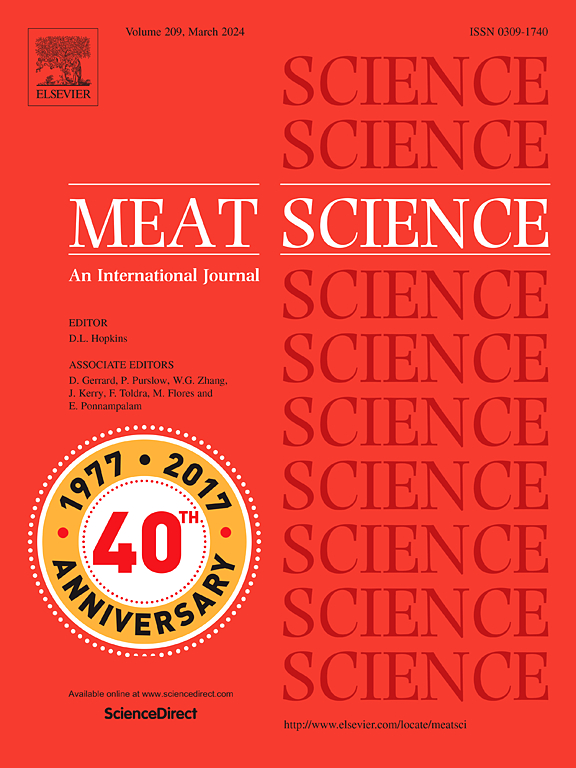Stunning pigs with inert gases at low residual oxygen does not compromise meat quality
IF 6.1
1区 农林科学
Q1 Agricultural and Biological Sciences
引用次数: 0
Abstract
In the project for “Testing Inert Gases in order to Establish Replacements for high concentration carbon dioxide (CO2) stunning for pigs at the time of slaughter” (TIGER), we were investigating the effect of different inert gas atmospheres on meat quality. In two subsequent experiments a total of 1138 pigs were either stunned with argon or nitrogen (N2) as well as mixtures of those with 10–30 % CO2 or two high concentration CO2 atmospheres. With a newly developed and patented gas supply technology, we were able to create stunning atmospheres with a residual oxygen concentration < 1 %. In both experiments various meat quality traits (pH, temperature, and electrical conductivity) were assessed in M. longissimus thoracis et lumborum (LTL) and M. semimembranosus (SM) 45 min and > 24 h post mortem, respectively. Drip loss, cooking loss, razor shear force and color (CIE L*a*b) were examined for the LTL (experiment 1) and for the SM (experiment 2). Additionally, sensory analyses were carried out in the second experiment. Statistically significant differences between meat quality traits were found in both experiments. For instance, a reduction of pH45 in LTL was observed when animals were stunned with high concentrations of N2, yet without causing the formation of pale, soft & exudative meat. Overall, the significant differences observed are considered of minor importance for consumers and meat processors. Therefore, we conclude from these experiments that the alternative gas mixtures investigated herein are not inferior to conventional CO2 stunning concerning meat quality of LTL and SM.
在低残余氧条件下用惰性气体击晕猪不会影响肉质
在“测试惰性气体以建立猪屠宰时高浓度二氧化碳昏迷的替代品”(TIGER)项目中,我们正在研究不同惰性气体气氛对肉质的影响。在随后的两个实验中,共有1138头猪被氩气或氮气(N2)以及含有10 - 30%二氧化碳或两种高浓度二氧化碳的混合物麻醉。凭借新开发的专利气体供应技术,我们能够创造出具有残余氧浓度的令人惊叹的气氛<;1%。在这两个实验中,我们分别对45分钟和45分钟后的胸腰长肌(LTL)和45分钟后的半膜长肌(SM)的肉质性状(pH、温度和电导率)进行了评估;分别是24小时后。对LTL(实验1)和SM(实验2)的滴漏损失、蒸煮损失、剃刀剪切力和颜色(CIE L*a*b)进行了检测。此外,在第二个实验中进行了感官分析。两个试验的肉质性状差异均有统计学意义。例如,当动物被高浓度的N2麻醉时,观察到LTL中pH45的降低,但没有引起苍白,柔软的&;渗出性肉。总的来说,观察到的显著差异被认为对消费者和肉类加工商的重要性不大。因此,我们从这些实验中得出结论,本文所研究的替代气体混合物在肉质方面并不亚于传统的CO2惊艳。
本文章由计算机程序翻译,如有差异,请以英文原文为准。
求助全文
约1分钟内获得全文
求助全文
来源期刊

Meat Science
工程技术-食品科技
CiteScore
12.60
自引率
9.90%
发文量
282
审稿时长
60 days
期刊介绍:
The aim of Meat Science is to serve as a suitable platform for the dissemination of interdisciplinary and international knowledge on all factors influencing the properties of meat. While the journal primarily focuses on the flesh of mammals, contributions related to poultry will be considered if they enhance the overall understanding of the relationship between muscle nature and meat quality post mortem. Additionally, papers on large birds (e.g., emus, ostriches) as well as wild-captured mammals and crocodiles will be welcomed.
 求助内容:
求助内容: 应助结果提醒方式:
应助结果提醒方式:


